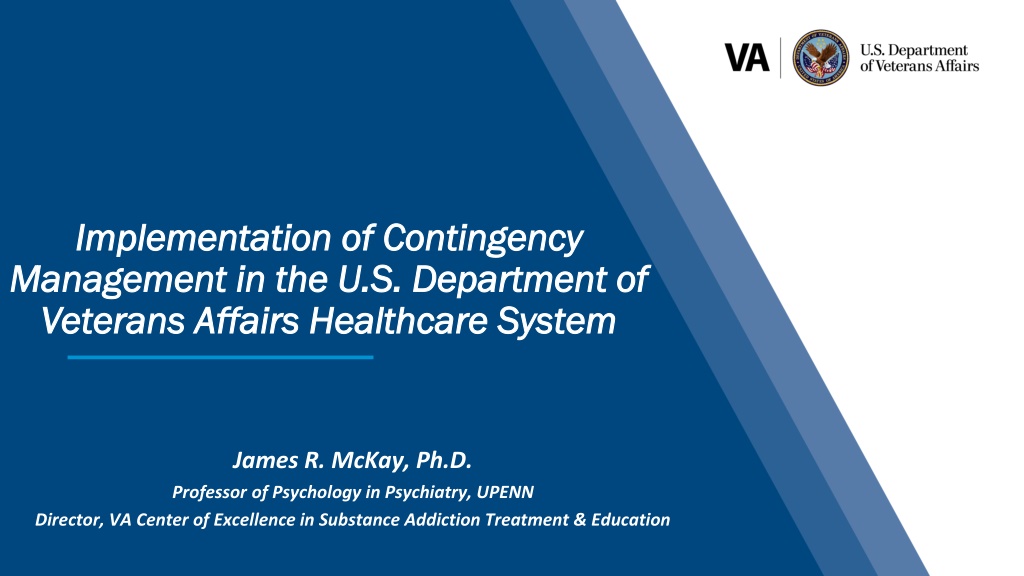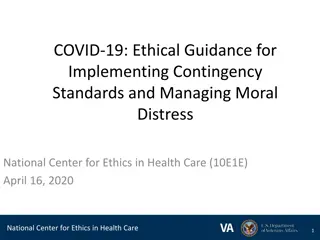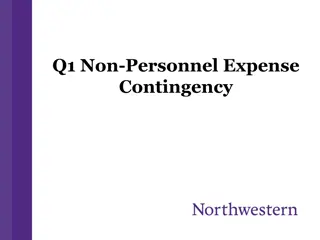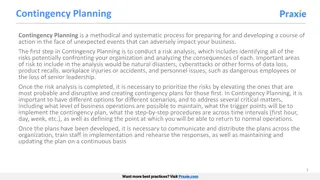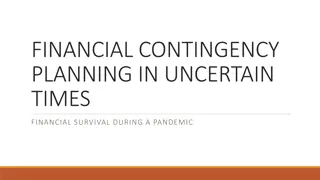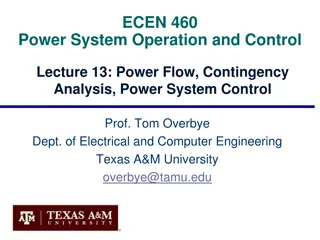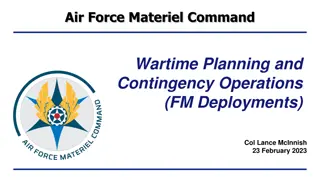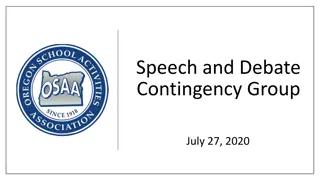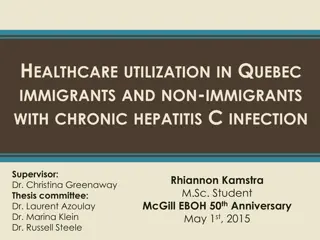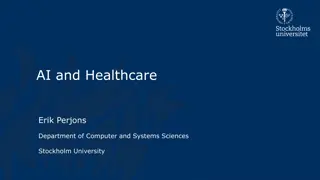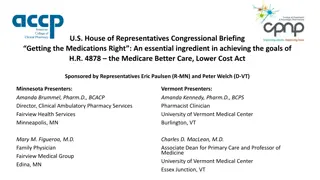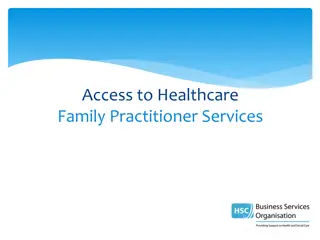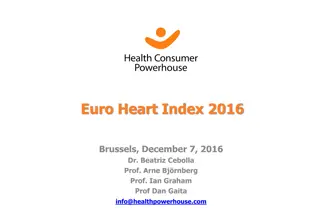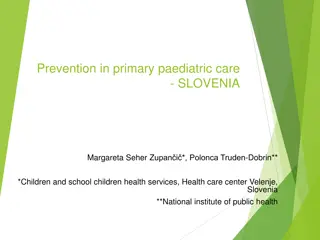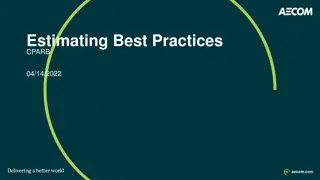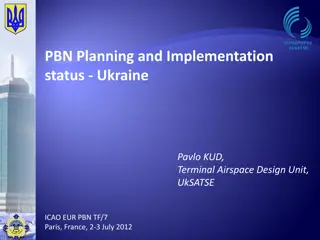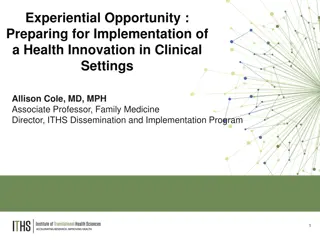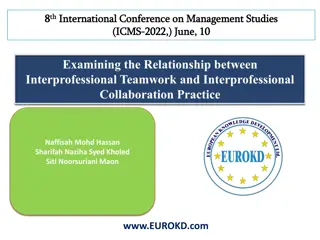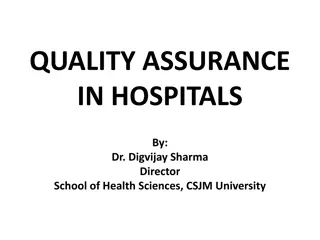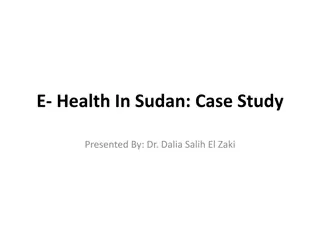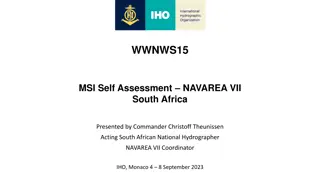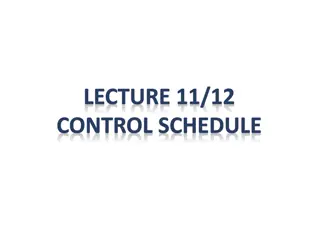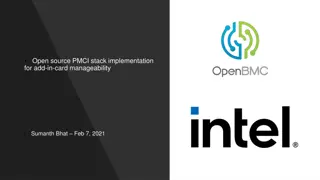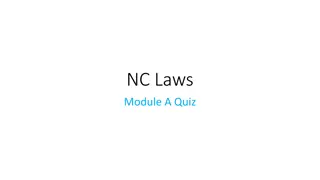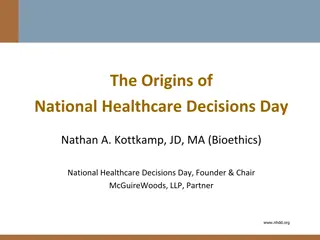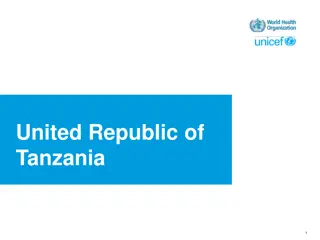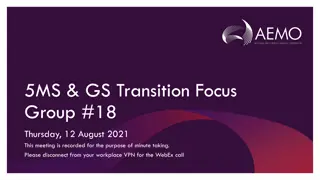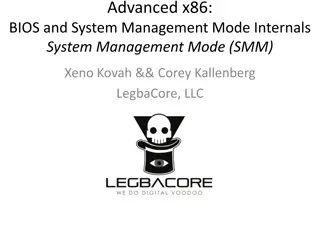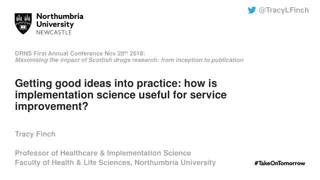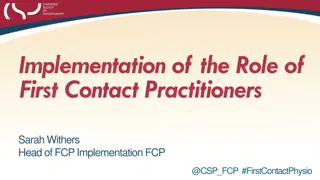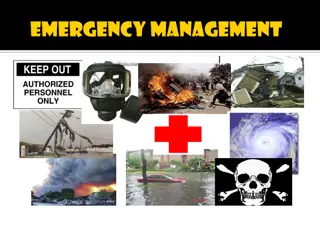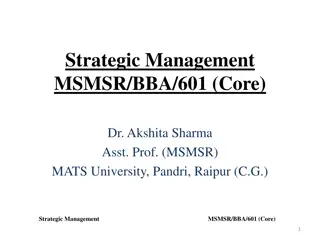Implementation of Contingency Management in VA Healthcare System
The implementation of Contingency Management (CM) in the U.S. Department of Veterans Affairs (VA) Healthcare System was driven by the effectiveness of CM in treating stimulant use disorder. Training and dissemination efforts were conducted to educate clinicians and ensure proper implementation. VA used incentives like point-of-care testing supplies and Veteran Canteen Service coupons to motivate participation. The program aimed to improve treatment outcomes for Veterans with substance use disorders.
Uploaded on Sep 29, 2024 | 0 Views
Download Presentation

Please find below an Image/Link to download the presentation.
The content on the website is provided AS IS for your information and personal use only. It may not be sold, licensed, or shared on other websites without obtaining consent from the author. Download presentation by click this link. If you encounter any issues during the download, it is possible that the publisher has removed the file from their server.
E N D
Presentation Transcript
Implementation of Contingency Implementation of Contingency Management in the U.S. Department of Management in the U.S. Department of Veterans Affairs Healthcare System Veterans Affairs Healthcare System James R. McKay, Ph.D. Professor of Psychology in Psychiatry, UPENN Director, VA Center of Excellence in Substance Addiction Treatment & Education
Impetus for implementing CM in VA VA/DoD SUD clinical practice guideline (CPG) that came out in 2009 concluded that CM was our most effective treatment for stimulant use disorder. Based on the SUD CPG, VA leadership decided in 2011 that CM should be made available to Veterans with stimulant use disorder receiving treatment in VA SUD specialty programs, after noting that only 1% of VA patients with substance use disorder had received CM in 2010. The Philadelphia Center of Excellence in Substance Addiction Treatment and Education (CESATE) was tasked with developing and implementing a plan to disseminate CM widely in VA SUD programs. Dr. Dom DePhilippis from the CESATE worked with Dr. Nancy Petry to develop the CM protocol, which was based around Dr. Petry s fishbowl approach
Training and Dissemination Efforts VA supported four regional in-person 1.5 day trainings for 187 clinical leaders and providers from 113 VA intensive outpatient programs (IOPs): Trainings included didactics, demonstrations, group exercises, videos of CM administration Behavioral principles underlying CM were described and role plays were conducted Pre-implementation planning calls provided for 12 months after the in-person trainings 2-6 programs per call Used to develop the protocol and forms for each site and address any concerns about CM Post-implementation coaching calls (four in the first 6 months following enrollment of the first CM patient and then once very 6 months thereafter) Reviewed CM implementation forms that contained data on patients enrolled, samples collected, test results, and timeliness of providing results to participants The first call was convened roughly 30 days after the first patient began CM at a site. The second call occurred 1-2 months later to review progress. Calls 3 and 4 occurred at roughly 150 and 180 days after the first patient began CM at a site.
Incentives used in the VAs CM program VA initially made funds available to participating facilities to purchase at least $5,000 in point of care testing supplies and/or Veterans Canteen Service (VCS) coupons that could be redeemed at VCA canteens, cafeterias, or coffee shops in VA facilities The VCS canteens are like mini general stores, with goods that range from candy bars to flat screen TVs. The canteens do not sell nicotine products, alcoholic beverages, gambling paraphernalia, pornographic materials, or weapons. Veterans participating in CM were able to bring their coupons earned from stimulant free urine tests to the canteens and redeem them for store items. We fairly quickly ran through the funds that VA had allocated for rewards, and were faced with the possibility that sites might discontinue their CM program unless the incentive costs were covered locally by each site: However, VCS heard about the CM program and offered to donate over $100,000 per year to purchase canteen coupons More recently, VA had begun to provide substantial funds to support the CM program.
Implementation Progress and Sustainability Implementation By the end of 2012, 75 (69%) of the 108 CM-funded VA facilities had begun implementing CM This reflected the tireless efforts of Dr. Dom DePhilippis to persuade reluctant programs to start CM. At this point, 134 VA treatment facilities have implemented CM. Most programs reinforce abstinence verified by toxicology testing, some reinforce attendance or other recovery behaviors such as medication adherence. Sustainability Of the 134 programs that started CM, 119 have been subsequently awarded additional allotments of VCS coupons to continue their program.
CM programs in VA Stimulant abstinence Attendance Adherence to injectable OUD/AUD meds (injectable naltrexone) Cannabis pilot track Pre-Operative pilot track (to reduce substance use prior to surgical procedures)
The Prize CM Protocol: Adherence to Injectable XR MOUD/MAUD
Published Outcomes of VAs CM Implementation: 2011-2015 Patient Enrollment in CM From June 2011 to December 2015, VA provided CM to 2,060 Veterans in 94 SUD treatment programs. Attendance Outcomes Patients completed 55.5% of possible CM sessions in a 12-week period. In comparison, Oliva et al. (2013; Psychiatr. Serv.) found that only 42% of VA patients with an outpatient SUD treatment episode completed more than two sessions of care in a one-year period. Substance Use Outcomes 91.9% of the 27,850 Veterans urine samples tested negative for the target substance.
VAs Abstinence CM Implementation: Outcomes Through FY22 115 VA stations have made CM reinforcing abstinence available to Veterans pursuing recovery from substance use disorder. Over 5,950 Veterans have received Abstinence CM; and 92% of the >76,500 urine samples have tested negative for the target drug (e.g., stimulants or cannabis) Regarding retention, the number of samples provided divided by the number of Veterans who ve received CM is ~13 samples. Since CM involves twice-weekly sampling, the mean retention in treatment among CM patients is ~6.5 weeks (notably longer than typical retention in VA SUD outpatient programs).
VAs CM program to reinforce use of injectable meds 27 VA sites have participated Total of 589 veterans Mean number of injections while receiving CM= 4.88 (sd= 4.34) 10+: 16%; 5-9: 25%; 3-4: 20%; 1-2: 39% Active= 4.92; Not Active= 4.84 No Injections prior to CM= 4.72; Injections prior to CM= 5.35 Mean number of consecutive injections received = 4.41 (sd=3.55) Active= 4.40; Not Active= 4.41 No Injections prior to CM= 4.45; Injections prior to CM= 4.47 Results indicated veterans receive injections each month until they dropout
How do these results compare to other studies? Prior studies that have examined rates of injectable naltrexone use without incentives have produced mixed results: Systematic review (Jarvis et al., 2018) found that in retrospective chart review studies, 50% of patients got a third injection and only 10% adhered through six injections. However, in prospective studies in Jarvis et al., rates of perfect adherence out to six months ranged from 15% to 74%! In Vets, one study found mean of 5 injections over 12 months (Chang et al., 2018), another reported that proportion of days covered out to six months was 57% (Stewart et al., 2021) When CM was used to incentivize adherence, participants received 87% of six possible injections in one study (DeFulio et al., 2012) and 63% of participants received all six injections in a second study (Jarvis et al., 2018) These results suggest that the mean of around 4-5 injections we saw in our VA pilot is not appreciably better than what has been found in other VA samples without CM and not as high as in studies that used CM. We may need to adjust our reinforcement schedule for injectable SUD meds to provide more reinforcement.
Why has the CM implementation worked so well in VA? VA/DoD SUD CPG strongly endorsed CM for stimulant use disorder VA leadership took that seriously Directed VA programs to implement CM Provided funding for training and incentives Developed practical CM protocol with help of Dr. Petry Presence of VCS stores in VA facilities The Dom Effect (i.e., Dr. Dominick DePhilippis): Use evidence, directives from on high, persuasion, problem solving, customized support, etc. Do not take no for an answer! Provision of more than $100K per year in incentives by VCS
Challenges Covid! Sharply decreased participation in all CM programs as in person attendance plummeted. But we are moving in the right direction again! Current Status: Abstinence CM: 53 programs participating Injection adherence CM: 21 programs participating Considering a pilot with home oral fluid testing observed via smartphone. However, a small study we just completed found high rates of false positives in oral tests, compared to urine toxicology.
Challenges How to implement CM in VA satellite clinics without VCS stores (CBOCS)? Set up small prize cabinets in each facility with low-medium cost items, with cooperation of VCS For higher priced items, vets will order from VCS online catalogue Funding for incentives and rapid test kits After initial funds provided by VA were used up, no further funds were provided for several years (except end of fiscal year lag funds ) However, in past year VA has committed substantial sums of money to support CM Concerns related to point-of-care testing by VA labs
How can the VA experience facilitate wider use of CM in routine care? It already has! Success in VA contributed to decision by California to undertake a large-scale implementation of CM. Considerable press coverage of VA CM outcome article generated much interest Need for those in clinical leadership positions to be aware of the efficacy of CM Even with considerable support from leadership, champions on the ground are essential to overcome resistance at treatment program level and address misinformation regarding CM VA experience does not suggest that reinforcing abstinence in stimulant disorder patients causes any problems with patients who are not getting reinforced for abstinence. Funding needed for incentives and rapid test kits. One possible source might be corporations that want to partner to improve population health. Ideal partners would be organizations similar to VCS, but outside of VA, that could offer incentives, e.g. gift cards, redeemable at their stores.
Thanks to: Dominick DePhilippis Carl Wayne Wesley Gabriela Khazanov Joe Liberto Jennifer Burden Karen Drexler Dan Kivlahan Seattle CESATE All the CM champions at VA programs across the country and the VA clinicians who have provided CM!
